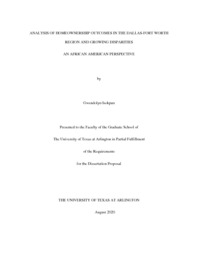| dc.description.abstract | Since the housing bust and Great Recession, in the United States, the homeownership gap between black and white households has widened to its largest levels in 50 years (Choi, McCargo, Neal, Goodman & Young, 2019). With overall inequality continuing to grow, policy decisions must be implemented to begin to mitigate the decreasing levels of homeownership. I argue decreased levels of homeownership are one contributing factor to inequality. More specifically, for African Americans, the homeownership rates have decreased back to the levels during the Civil Rights Era. Within the United States, owning a home is considered an important social and economic indicator, as well as a symbol of having a stake in society and contributing to the stability of the community (Collins, 2002). Research indicates, when compared to renting, homeownership for any length of time is associated with a higher level of wealth (Leigh and Huff, 2007). However, the Great Recession, fueled by the crisis in the housing and financial markets, was universally hard on the net worth of American families. But even as the economic recovery had begun to mend asset prices, not all households had benefited alike and wealth inequality had widened along racial and ethnic lines (Kochhar and Fry, 2014). In addition, with stagnate wages and rising home prices, the American dream has become more elusive for many low to middle-income American households regardless of race and ethnicity, thus creating a more unequal society.
Spatially, economics and demographics differ significantly throughout the United States and there is a lack of in-depth regional analysis on homeownership within individual metropolitan areas. To further contribute to inequalities, housing researchers tend to neglect local homeownership analysis based on disaggregated data for cities. Disaggregating data is crucial to revealing patterns that can be masked by larger aggregate data. As a result, segments of the population are left out and inequalities continue to increase, with a disproportional impact on ethnic minorities, especially African Americans.
The purpose of this proposed study is to conduct a systematic analysis of the homeownership rates with a focus on African Americans in the Dallas-Fort Worth (DFW) region of Texas. The study will take a social equity perspective and examine the association of demographics and homeownership rates. Quantitative statistical analysis will be utilized to explain homeownership outcomes and its association to equity. Analyzing specific sub-populations can help ensure policy decisions are formulated and implemented where it is most needed and have a greater impact. This study contributes to the current housing crisis and decreased opportunities of homeownership for many households, particularly African Americans, along with the historical and social context contributing to this crisis. | |


